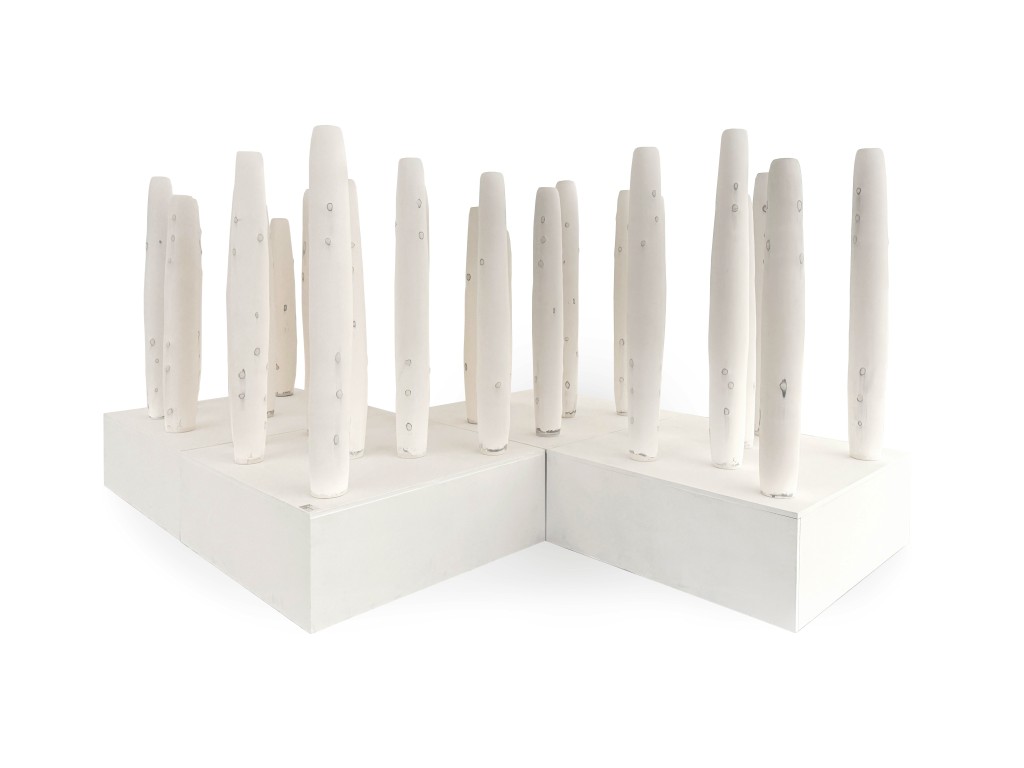In 2024 and 2025, Elisabeth Cummings collaborated with ceramicist Jane Barrow to create the works in this exhibition, a suite of painted hand-thrown porcelain pieces. The ceramic practice of Jane Barrow is grounded in engagement with historic Japanese pottery tradition and connection with the natural environment. In Jane’s words, ‘For a ceramist, form is not just shape—it’s a negotiation between material, intent, and the elusive beauty of the natural world’. In these collaborative works, Elisabeth’s painted scenes are imbued through the process of pottery with elemental forces – the water of glaze, the earth of mineral pigment, the wood of ash, the fire of the kiln. In Elisabeth’s 2017 monograph, Sioux Garside, curator and longtime friend of Elisabeth, wrote, ‘private, immersive interior spaces run like a golden thread through the centre of Elisabeth’s art and life.’ Painted in glazes of vibrant blues and rusty earth tones, the scenes in this collaboration continue this thread – birds in a garden, tea with loved ones, fruit on tables, a potted plant – crossing between the borderlines of abstraction and representation, nature and domesticity, memory and imagination.
In the early 1960s, Elisabeth Cummings collaborated with Mexican-born ceramicist Lino Alvarez Carrasco, who describes himself as a “landscape potter”. The term resonated with Elisabeth, who has returned time and time again to her interest in landscapes of memory over the course of her artistic career. During their collaboration, Elisabeth and Lino created a series of earthenware tableaux sculptures, of which some were later cast in bronze. These intimate interior scenes used the vessel as a point of departure. The motif of the vessel has persisted across Elisabeth’s practice, with vases, bowls, plates and pots as recurring forms in both her painted interiors and ceramic collaborations. As an elemental form, the ceramic vessel transforms the raw material of the earth into an object of private life – a vase, a bowl, a plate, a pot. The vessel as an object brings together Elisabeth’s reverence for nature and for everyday life.
Art historian and curator Terence Maloon describes Elisabeth’s art as ‘attuned to vibration – to thronging energies that course through a landscape, ricochet between the surfaces of a confined space and riddle a painted surface to bursting point’. In her collaborations with ceramic artists, Elisabeth imbues the physical form of the vessel with an inner life, the quivering all-encompassing energy of her canvas paintings. In 2001, Elisabeth collaborated with Barbara Romalis, one of the founding members of the Wedderburn artist community, for the exhibition Collaborative Pots at Chapman Gallery, Canberra. Beginning in the early 2010s, Elisabeth worked with contemporary artist Louise Boscacci, now Head of Ceramics at the National Art School, for over a decade. Notably, for their touring exhibition Cicada Waterfall in 2014, Elisabeth and Louise created wide cylindrical works that evoked the salt-encrusted claypan landscapes of northern Queensland.
In 2024 and 2025, Elisabeth Cummings collaborated with ceramicist Jane Barrow to create the works in this exhibition, a suite of painted hand-thrown porcelain pieces. The ceramic practice of Jane Barrow is grounded in engagement with historic Japanese pottery tradition and connection with the natural environment. In Jane’s words, ‘For a ceramist, form is not just shape—it’s a negotiation between material, intent, and the elusive beauty of the natural world’. In these collaborative works, Elisabeth’s painted scenes are imbued through the process of pottery with elemental forces – the water of glaze, the earth of mineral pigment, the wood of ash, the fire of the kiln. In Elisabeth’s 2017 monograph, Sioux Garside, curator and longtime friend of Elisabeth, wrote, ‘private, immersive interior spaces run like a golden thread through the centre of Elisabeth’s art and life.’ Painted in glazes of vibrant blues and rusty earth tones, the scenes in this collaboration continue this thread – birds in a garden, tea with loved ones, fruit on tables, a potted plant – crossing between the borderlines of abstraction and representation, nature and domesticity, memory and imagination.

Presented alongside the collaborative ceramic works of Elisabeth Cummings at King Street Gallery, this iteration of Fragments of Stillness extends my exploration of ceramic form and spatial resonance through the inclusion of new locally inspired Architectural Biomorphic forms—sculptural vessels that echo the rhythms of nature in human and spiritual form.
My artwork is grounded in both a Japanese ceramic tradition and a contemporary installation practise, drawing on cross-cultural experiences to express a deeply personal, spiritual relationship with the Australian landscape. I am drawn to the subtle power of the concept of emptiness and repetition, and to the ways in which ceramic forms relate to the architectural environments they inhabit.
The act of throwing and hand forming vessels is both intuitive and deliberate. It reflects my ongoing fascination with the containment of space—a principle that underpins both ceramics and architecture. These forms are not just containers of volume, but vessels of memory and meaning, offering a physical and sensory encounter with both object and void.
Without a defined ancestral lineage, I engage with place through memory, association, and myth. In this series, the Biomorphic Beings serve as quiet emissaries—part relic, part presence—speaking to a hybrid spirituality rooted in land, body, and silence.
They are directly inspired by the riparian rock formations that surround me on the Hawkesbury River where I live and work
Through clay, I seek not to conquer nature, but to listen—and to leave space for what cannot be fully held
In dialogue with Cummings’ expressive painterly interpretations of the Australian environment, my work invites a complementary stillness. Together, our practices offer a conversation between gesture and form, between movement and stillness, and between the enduring presence of landscape and the traces it leaves within us.
— Jane Barrow, 2025